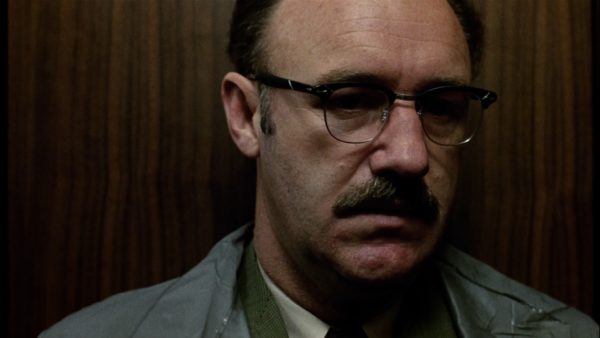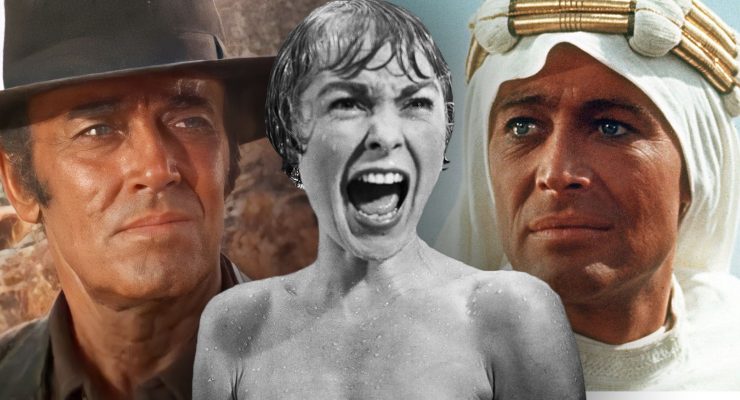In the latest instalment of Flickering Myth’s film class, Tom Jolliffe looks at the audio and visual tools a film-maker can effectively use to portray a characters descent into madness…
In previous film classes (which I should say are merely showcases for films that excel in whatever subject springs to my mind before writing) I’ve covered a range of aspects from the technical to the aesthetic and more. However in this instalment I want to delve deeper into character, and in particular the audio and visual tools a film-maker can use in order to effectively portray a descent into madness.

It’s particularly important that these tools are used creatively when the character in question is generally quiet. When he seems inactive until that inevitable moment when he fully unravels into explosive behaviour. I’ve covered films in previous instalments (and other articles) which I could easily have focused on here. At a passing poke into my data banks, The Conversation and American Psycho immediately spring to mind (though the latter also portrays insanity through dialogue and narration too).
The film I really want to focus on however, is Martin Scorsese’s masterpiece, Taxi Driver. In Scorsese’s films, generally there is a particularly strong focus on dialogue. He’s got a panache for films with sharp dialogue. Tough talkers, smooth talkers. Whilst Marty isn’t always a writer, he’s obviously got an eye for a script with colourful (And often telling) dialogue. Taxi Driver is a film which is so focused on the internal. It’s a dark, disturbing and complex tale which is completely different from the rest of his career. You could look at Mean Streets, Raging Bull, Goodfellas, Casino and The Departed for example. All classic films in their own right. All fantastic, but all have a commonality where they could exist in the same universe. Taxi Driver stands apart. This film isn’t about interaction or relationships (in a connective sense) or familial drama. It’s about the fragmentation of Travis Bickle’s psyche. He’s an outsider, whose deep thinking and reflective isolation leads him down a dark path to some kind of reactive retribution.
De Niro’s internalised and quiet performance (as far as his career goes this is also an out of the ordinary role) is magnetic. He’s exceptional here, conveying so much through doing so little (on the surface). What sets Taxi Driver apart from something like American Psycho say, is that there’s no hint of irony. There’s no playful jab or insight into the sub-culture it’s mocking (like the 80’s yuppy in the latter). What makes Taxi Driver disturbing, and what sticks with you is the fact you can believe the genesis of Travis Bickle. You can believe his creation as a fiction that has a distinct stamp of reality to him. Bickle can exist and probably has. From De Niro’s gaunt features, sleepless eyes and internalised struggles to rationalise human behaviour (and his own interactions), we have a character who is frighteningly believable.
In addition to De Niro’s fully invested performance everyone behind camera must combine to add further layers of depth to the film and indeed aid in portraying said breakdown. Films can portray eccentricity, insanity, craziness, sociopathic tendencies and do so without much subtlety. In fact occasionally, said roles offer a chance to let go. However when you want to show this with almost full restraint, the director, cinematographer, composer (and more of course) can tilt the audience further into believing that the unravelling of the mind is in progress.
Before I get onto Scorsese’s part I’ll talk a little about Bernard Herrmann’s score. Herrmann was long-established in the industry at this point. A veteran of the scoring world who had started with Citizen Kane and by the mid 70’s had been winding down. Best known for his iconic music in Psycho, Scorsese brought Herrman on board this dark psychological tale of PTSD in the darkest corners of New York City. Herrmann had plenty of previous in musically portraying mental implosion with the likes of Vertigo and indeed Psycho.
From the outset as the film opens, bursts of percussion and brass swells threaten to burst the ear drum, before melding into this smooth light and warming jazz which caresses the speakers. It almost seems at odds with the murky back streets laden with mist and dirt, hoods, pimps and hookers. Then the music takes a turn again. Swells of brass and percussion that return to break out of that calming tuneful jazz. This constant battle between the melancholic and considered to the uncontrolled perfectly mirrors how Bickle exists as a character. He’s in constant quandary. Has he always been like this? Is it just post-Vietnam? Who knows but Bickle is at consistent odds with the acceptance of criminality. He just wants peace and a City he can inhabitant which isn’t filled with detritus. Herrmann’s beautifully, near chaotic score demonstrates this constant conflict between the differing states of Bickle’s mind, dependent on what he’s interacting with, or who. In addition ambient background noise, and silence also play key parts throughout the film as they infiltrate Bickle’s psyche in different ways.
Even as we look at that opening again we can look at the visual side. Again there is an image at odds. On the one hand it’s mist, filth, dirt, darkness, but at same time the wet glow of street lights reflecting on sodden streets and the neon lights of night-time in New York are inherently beautiful. In amongst the dirt, the dark, the filth and the badness, there is good. There is beauty. Bickle may well break down into a killing frenzy, armed with righteousness and a selection of firearms, but without him, within the obsessive need to impose his brand of justice, there is goodness. There’s this need to feel worth and to help those in need. Ultimately there is a part of him doing this for a greater good.
Between Scorsese’s direction and Michael Chapman’s cinematography there is this great union of reality and fantasy. The New York depicted looks both real, unflattering and repulsive, but at the same time with these almost dazzling amber and coloured neon glows. The use of water, mist, steam, and other visual elements you can almost feel just make the film evoke a sense of duplicity. Images which at once show ugliness and beauty are often hard to pull off, but Taxi Driver does this in abundance.
Scorsese likewise employs a number of startling visual techniques throughout the film which reflect a disconnection with reality. One scene in particular sees Bickle making a phone call in the corridor of a building. Whilst aesthetically the shot in question will not make initial sense, upon reflection it makes perfect sense. Bickle makes a call to apologise to Betsy (having taken her to a porno on their first date…schoolboy error). It’s a simple scene in and of itself but as the camera, almost seeming to get bored, tracks away from Travis, it then focuses on an empty corridor as he continues the conversation out of shot. It’s an awkward almost banal conversation but it represents this inability for Bickle to exist in the normal realms of society. That lingering final shot on an empty corridor, we’ve disconnected as an audience from Bickle because we cannot connect with him, he cannot connect with anyone.
Throughout there are more choices Scorsese makes which represent a wall between Bickle and everyone else. It could be the scene between Bickle and the Wizard (Peter Boyle). Bickle against his usual nature seeks the counsel of someone he deems older, wiser and who may have an answer for the conflict eroding his mind. The scene itself is bathed in red lighting. It’s almost like a warning of what’s to come. It’s a telling moment as part of Bickle that still has a light grip on civility wants to possibly step back into the light. He needs answers, coping mechanisms but Wizard has no idea what Bickle is really after. In his confused state he cannot elaborate on what answers he needs from Wizard. The scene offers no answers but enforces the idea that this could have pulled Bickle away from his inevitable ending, instead that visual palette tells us how the scene will go before it has even played out.
Even in witnessing the sociopathic tendencies of other characters, Bickle is distant. He can’t associate with civilised society, nor the uncivilised. He feels truly alone. He’s driven to potentially reprehensible acts (attempting to assassinate a senator) or to murder in the name of justice. Scorsese’s own cameo in the film is a brilliant scene. So simply set up as far as framing goes. We’re split between a mid of Scorsese, a mid of De Niro, framed as such so we don’t see Scorsese in the rear of the cab. Then there’s an intermittent shot from behind Bickle which establishes he never directly looks at Scorsese. He doesn’t wish to acknowledge him directly or become too infected with what his passenger is saying (they never share the frame. A distance established). Occasional glances at his passenger in his mirror but little more. He listens, he considers and feels cold at what is essentially a pre-meditated murder confession. Such is the intensity of Scorsese’s performance you would assume that the deed will be carried out. You could judge from Bickle’s wariness of black people that he wilfully chooses to ignore this confession and move on with his own moral quandaries. Perhaps the fact that the passenger’s wife is supposedly sleeping with a black man causes Bickle to almost morally, albeit indifferently, accept that the punishment fits the crime.
Scorsese will also often linger on De Niro as he stares in an almost dazed state. Even that chilling, post shootout shot, after he’s failed to kill himself following his rampage, he just sits, starring coldly, mimicking a gun trigger pulling with his hand at his head. That cold, near dead stare sees a telling admittance that he’s stepped over the precipice and doesn’t care any more. The denouement that follows may suggest a potential turnaround to normality for Bickle, but as the closing shot, with a beautiful cohesion of jarring sound and visual points out, probably not.
As much as I could ingest the internets entire storage capacity with an even more in-depth analysis of Taxi Driver I will leave it at that point but ask readers to share their thoughts on this film, and indeed any others which combine sound and visuals so effectively to portray mental instability.
Tom Jolliffe










